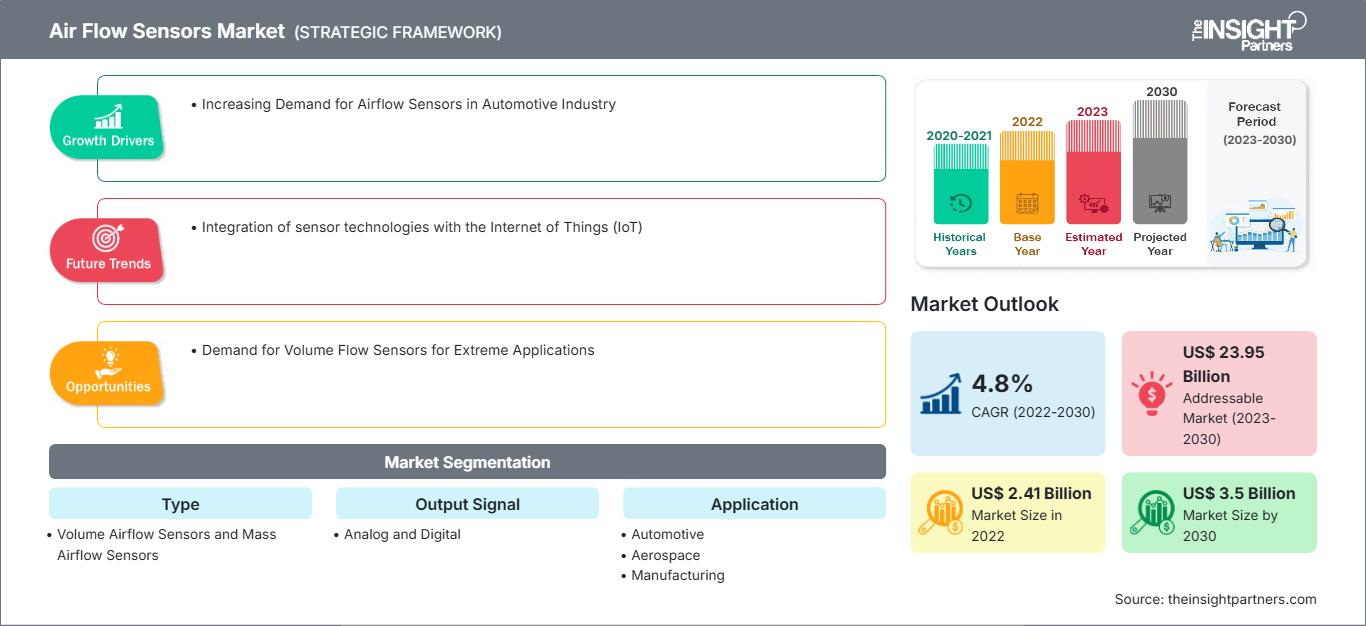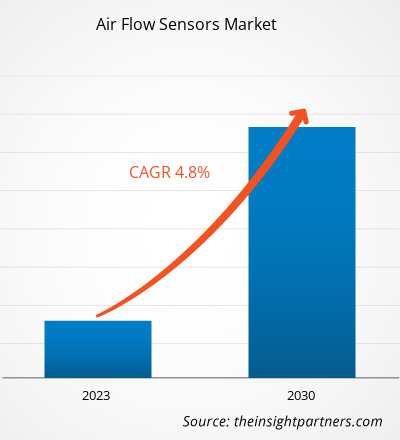공기 흐름 센서 시장 규모는 2022년 24억 1천만 달러에서 2030년에는 35억 달러에 이를 것으로 예상됩니다. 2022년부터 2030년까지 연평균 성장률(CAGR)은 4.8%에 이를 것으로 예상됩니다. 사물 인터넷(IoT)과 센서 기술의 통합은 시장의 주요 트렌드로 남을 것으로 보입니다.
공기 흐름 센서 시장 분석
HVAC 시스템은 효율적인 작동을 보장하고 에너지 소비를 줄이기 위해 공기 흐름 센서를 사용합니다. HVAC 시스템에는 해당 구역의 실제 온도와 목표 온도를 비교하여 적절한 조치를 취할 수 있는 공기 흐름 센서가 있습니다. HVAC 제어는 호텔, 기업, 소매, 주택 등 다양한 산업 분야에서 자주 사용됩니다.
공기 흐름 센서 시장 개요
공기 흐름 센서는 채널 내 공기 흐름의 양 또는 질량을 측정하는 데 사용됩니다. 공기 흐름 센서에는 질량 공기 흐름 센서와 체적 공기 흐름 센서의 두 가지 유형이 있습니다. 공기 흐름 센서는 설치가 간편하며, 전체 압력, 공기 흐름의 정압, 그리고 공기 속도를 측정합니다. 공기 흐름 센서는 광범위한 산업 시스템에 적용됩니다. 자동차에서 공기 흐름 센서는 최적의 연비와 배기가스 배출량을 유지하는 데 필수적이며, 엔진 제어 장치가 효율적인 연소를 위해 연료 분사를 조절하도록 지원합니다.
요구 사항에 맞게 이 보고서를 사용자 정의하십시오.
이 보고서의 일부, 국가 수준 분석, Excel 데이터 팩을 포함하여 모든 보고서에 대한 사용자 정의를 무료로 받을 수 있을 뿐만 아니라 스타트업 및 대학을 위한 훌륭한 제안 및 할인을 이용할 수 있습니다
공기 흐름 센서 시장: 전략적 통찰력

- 이 보고서의 주요 주요 시장 동향을 확인하세요.이 무료 샘플에는 시장 동향부터 추정 및 예측에 이르기까지 데이터 분석이 포함됩니다.
이 보고서의 일부, 국가 수준 분석, Excel 데이터 팩을 포함하여 모든 보고서에 대한 사용자 정의를 무료로 받을 수 있을 뿐만 아니라 스타트업 및 대학을 위한 훌륭한 제안 및 할인을 이용할 수 있습니다
공기 흐름 센서 시장: 전략적 통찰력

- 이 보고서의 주요 주요 시장 동향을 확인하세요.이 무료 샘플에는 시장 동향부터 추정 및 예측에 이르기까지 데이터 분석이 포함됩니다.
공기 흐름 센서 시장 성장 동력 및 기회
자동차 산업의 공기 흐름 센서 수요 증가로 시장 활성화
자동차 산업은 공기 흐름 센서의 주요 최종 사용자입니다. 자동차 수요 증가는 공기 흐름 센서에 대한 수요를 동시에 증가시키는데, 이는 이러한 센서가 엔진 및 배기 시스템에서 공기 흐름을 모니터링하고 제어하는 데 사용되기 때문입니다. 자동차 산업은 전 세계적으로 빠르게 성장하고 있으며, 전 세계적으로 전기차 보급률도 크게 증가하고 있습니다. 유럽 위원회에 따르면 자동차 산업은 1,380만 명의 유럽인에게 직간접적인 일자리를 제공하며, 이는 유럽 전체 고용의 15.1%를 차지합니다. 유럽 교통환경연맹(EFE)이 인용한 통계에 따르면, 영국 정부는 2050년까지 탄소 순배출량 제로(Net Zero) 목표를 설정하고 2035년까지 모든 오염 차량의 판매 금지를 제안했습니다. 따라서 탄소 순배출량 제로 정책과 소비자들의 친환경 차량에 대한 수요가 공기 유량 센서 시장을 견인하고 있습니다.
극한 환경용 체적 유량 센서 수요
자동차, 항공우주, 제조, 전력 및 유틸리티 등 다양한 산업 분야에서 극한 환경을 견딜 수 있는 체적 유량 센서에 대한 수요가 매우 높습니다. 이러한 수요 증가는 시장 참여자들이 극한 환경용 체적 유량 센서를 개발하도록 유도합니다. 예를 들어, ENVEA는 2023년 9월, 극한 환경용 체적 유량 센서의 고온 버전인 AirFlow P를 출시했습니다. AirFlow P는 최대 800°C의 고온 어플리케이션에 적합한 먼지 부하 센서의 체적 유량 측정용 센서입니다.
공기 유량 센서 시장 보고서 세분화 분석
공기 유량 센서 시장 분석 도출에 기여한 주요 세그먼트는 유형과 응용 분야입니다.
- 유형을 기준으로 공기 유량 센서 시장은 체적 공기 유량 센서와 질량 공기 유량 센서로 구분됩니다. 체적 공기 유량 센서 부문은 2022년에 더 큰 시장 점유율을 차지했습니다.
- 응용 분야를 기준으로 시장은 자동차, 항공우주, 제조, 전력 및 유틸리티 등으로 구분됩니다. 자동차 부문은 2022년에 더 큰 시장 점유율을 차지했습니다.
지역별 공기 유량 센서 시장 점유율 분석
공기 유량 센서 시장 보고서의 지리적 범위는 주로 북미, 아시아 태평양, 유럽, 중동 및 아프리카, 남아프리카의 5개 지역으로 나뉩니다. 중앙아메리카.
일본, 인도, 중국, 호주, 싱가포르, 대만, 인도네시아와 같은 국가들은 전자, 식음료, 화학, 섬유, 자동차, 의료 등 다양한 제조업을 보유하고 있습니다. 또한, "중국 제조 2025" 및 "인도 제조"와 같은 정부 정책은 아시아 태평양 여러 국가의 이러한 산업을 활성화하여 공기 흐름 센서 수요를 촉진하고 있습니다. 중국은 항공우주 산업이 빠르게 성장하고 있습니다. 베이징의 기술에 정통한 후보자와 젊은 과학자들로 구성된 팀은 과거 창어 달 탐사선과 천문 화성 탐사와 같은 임무에서 중요한 역할을 수행했습니다. 이러한 항공우주 산업의 발전은 중국 공기 흐름 센서 시장 성장을 촉진합니다. 또한, 대기 질 모니터링의 중요성에 대한 인식이 높아짐에 따라 아시아 태평양 지역의 HVAC 시스템 수요가 증가하여 이 지역의 공기 흐름 센서 시장에 긍정적인 영향을 미치고 있습니다.
공기 흐름 센서 시장 지역별 통찰력
The Insight Partners의 분석가들은 예측 기간 동안 공기 흐름 센서 시장에 영향을 미치는 지역별 동향과 요인을 면밀히 분석했습니다. 이 섹션에서는 북미, 유럽, 아시아 태평양, 중동 및 아프리카, 그리고 중남미 지역의 공기 흐름 센서 시장 부문 및 지역별 현황도 다룹니다.
공기 흐름 센서 시장 보고서 범위
| 보고서 속성 | 세부 |
|---|---|
| 시장 규모 2022 | US$ 2.41 Billion |
| 시장규모별 2030 | US$ 3.5 Billion |
| 글로벌 CAGR (2022 - 2030) | 4.8% |
| 이전 데이터 | 2020-2021 |
| 예측 기간 | 2023-2030 |
| 다루는 세그먼트 |
By 유형
|
| 포함된 지역 및 국가 | 북미
|
| 시장 선도 기업 및 주요 회사 프로필 |
|
공기 흐름 센서 시장 참여자 밀도: 비즈니스 역학에 미치는 영향 이해
공기 유량 센서 시장은 소비자 선호도 변화, 기술 발전, 그리고 제품 이점에 대한 인식 제고 등의 요인으로 인한 최종 사용자 수요 증가에 힘입어 빠르게 성장하고 있습니다. 수요가 증가함에 따라 기업들은 제품 라인업을 확장하고, 소비자 니즈를 충족하기 위한 혁신을 추진하며, 새로운 트렌드를 적극 활용하고 있으며, 이는 시장 성장을 더욱 가속화하고 있습니다.

- 을 얻으세요 공기 흐름 센서 시장 주요 주요 플레이어 개요
공기 유량 센서 시장 뉴스 및 최근 동향
공기 유량 센서 시장은 1차 및 2차 조사 후 주요 기업 간행물, 협회 데이터, 데이터베이스 등 정성적 및 정량적 데이터를 수집하여 평가합니다. 공기 유량 센서 시장의 몇 가지 동향은 다음과 같습니다.
- 환경 모니터링 솔루션 분야의 선도적인 공급업체인 ENVEA는 최대 800°C의 온도를 견딜 수 있는 고온 버전을 출시하며 AirFlow P 센서 시리즈를 확장했습니다. 이 신제품은 AirFlow P 센서의 기능을 확장하여 더욱 까다로운 산업 분야에 이상적인 솔루션이 될 것입니다. (출처: ENVEA, 회사 웹사이트, 2023년 9월)
- Posifa Technologies는 호흡기 관리 및 기타 의료 및 계측 용도에 사용될 최신 버전의 질량 공기 유량 센서를 공개했습니다. PMF83000 및 PMF86000 시리즈 센서는 습도가 높고 부식성 가스 농도가 낮은 열악한 환경에서 사용하도록 설계되었습니다. (출처: Posifa Technologies, 회사 웹사이트, 2021년 4월)
공기 유량 센서 시장 보고서 범위 및 제공 내용
“공기 유량 센서 시장 규모 및 예측(2020~2030)” 보고서는 다음 영역을 포괄하는 시장에 대한 자세한 분석을 제공합니다.
- 범위에 포함된 모든 주요 시장 부문에 대한 글로벌, 지역 및 국가 수준의 공기 흐름 센서 시장 규모 및 예측
- 동력, 제약 및 주요 기회와 같은 공기 흐름 센서 시장 동향 및 시장 역학
- 자세한 PEST/포터의 5가지 힘 및 SWOT 분석
- 주요 시장 동향, 글로벌 및 지역 프레임워크, 주요 업체, 규정 및 최근 시장 개발을 포괄하는 공기 흐름 센서 시장 분석
- 시장 집중도, 히트맵 분석, 주요 업체 및 공기 흐름 센서 시장의 최근 개발을 포괄하는 산업 환경 및 경쟁 분석
- 자세한 회사 프로필
- 과거 분석(2년), 기준 연도, CAGR을 포함한 예측(7년)
- PEST 및 SWOT 분석
- 시장 규모 가치/거래량 - 글로벌, 지역, 국가
- 산업 및 경쟁 환경
- Excel 데이터세트
최근 보고서
관련 보고서
사용 후기
구매 이유
- 정보에 기반한 의사 결정
- 시장 역학 이해
- 경쟁 분석
- 고객 인사이트
- 시장 예측
- 위험 완화
- 전략 기획
- 투자 타당성 분석
- 신흥 시장 파악
- 마케팅 전략 강화
- 운영 효율성 향상
- 규제 동향에 발맞춰 대응




















 무료 샘플 받기 - 공기 흐름 센서 시장
무료 샘플 받기 - 공기 흐름 센서 시장